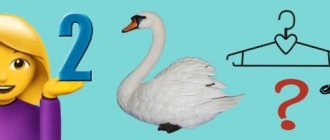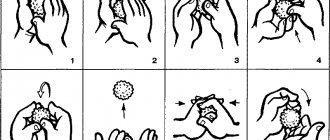Fathers and mothers strive to ensure that in nurseries, kindergartens, and then at school, children do not lose interest in acquiring new knowledge. And if it is too early to teach such children to read, then you can teach a child to count to 10 with a little effort. You need to get down to business in a playful manner and in a good mood. This is how children easily perceive new information and show interest in the further learning process.
From 1 to 10
To begin with, children are told a simple count, calling numbers from 1 to 10 one by one. You can start counting anything that arouses interest in the baby. During a walk, you and your son can count the cars parked at the entrance, the number of bows in a friend’s hair, the candies in the vase or the yoghurts in the refrigerator. You should try to interest your daughter in the number of items that interest her: balloons from the seller, hares on the page of her favorite book, dolls on the shelf in the nursery, etc.
Very often, parents involve their children in the world of mathematics at ease. For example, going up to her apartment, a mother asks her child to count the steps. Along the way, he draws attention to the numbers that mark the numbering of floors on the walls. It is useful to draw children's attention to the numbering of vehicles. “A little more and our bus number 9 will arrive. Look, isn’t that him?”
A supermarket can generally be regarded as a repository for a mass of teaching material. “How many bars of soap did we put in the cart? Is there chocolate here like you like? Let's take two tiles." It will also be useful to draw your child’s attention to the storage room number. “Look at the door number 7, and on the key tag there is also the number 7. The girl has 4 oranges in the bag, and do you want this fruit?”
Almost all children love the game of hide and seek. Parents should take advantage of this and combine business with pleasure.
“I count to five, but I can’t count to ten. One, two, three, four, five - I’m going to look.” At 3 years old, the baby will count, focusing on the intonation of his parents, and his words in pronunciation will bear little resemblance to the names of numbers, but by the age of 5, speech will become extremely clear.
The path to raising a child without punishment: 7 important steps
There are several special games and techniques that will tell parents how to teach a 4-year-old child to count. But most parents teach this in passing, but every day.
“How many fingers do you have on your right hand, and how many on your left? Count the dog's legs. What floor do we live on?
Where to start learning to count
At the first stage of learning mental arithmetic, it is necessary to teach the child to count within ten. We need to help him firmly remember the results of all variants of adding and subtracting numbers within ten, just as we adults remember them.
At the second stage of education, preschoolers master the basic methods of adding and subtracting two-digit numbers in their heads. The main thing now is not the automatic retrieval of ready-made solutions from memory, but the understanding and memorization of addition and subtraction methods in subsequent tens.
Both at the first and second stages, learning mental arithmetic occurs using elements of play and competition. With the help of educational games built in a certain sequence, not formal memorization is achieved, but conscious memorization using the child’s visual and tactile memory, followed by consolidation in memory of each learned step.
Why do I teach mental arithmetic? Because only mental arithmetic develops the child’s memory, intelligence and what we call ingenuity. And this is exactly what he will need in his subsequent adult life. And writing “examples” with long thinking and calculating the answer on the fingers of a preschooler does nothing but harm, because discourages you from thinking quickly. He will solve examples later, at school, practicing the accuracy of the design. And intelligence must be developed at an early age, which is facilitated by mental calculation.
Even before starting to teach a child addition and subtraction, parents should teach him to count objects in pictures and in reality, count steps on a ladder, steps while walking. By the beginning of learning mental counting, a child should be able to count at least five toys, fish, birds, or ladybugs and at the same time master the concepts of “more” and “less.” But all these various objects and creatures should not be used in the future for teaching addition and subtraction. Learning mental arithmetic should begin with addition and subtraction of the same homogeneous objects, forming a certain configuration for each number. This will allow the child to use the visual and tactile memory when memorizing the results of addition and subtraction in whole number groups (see video file 056). As a tool for teaching mental counting, I used a set of small counting cubes in a counting box (detailed description below). And children will return to fish, birds, dolls, ladybugs and other objects and creatures later, when solving arithmetic problems. But by this time, adding and subtracting any numbers in the mind will no longer be difficult for them.
For ease of presentation, I divided the first stage of training (counting within the first ten) into 40 lessons, and the second stage of training (counting within the next tens) into another 10-15 lessons. Don't be intimidated by the large number of lessons. The breakdown of the entire training course into lessons is approximate; with prepared children, I sometimes go through 2-3 lessons in one lesson, and it is quite possible that your child will not need so many lessons. In addition, these classes can be called lessons only conditionally, because each lasts only 10-20 minutes. They can also be combined with reading lessons. It is advisable to study twice a week, and it is enough to spend 5-7 minutes on homework on other days. Not every child needs the very first lesson; it is designed only for children who do not yet know the number 1 and, looking at two objects, cannot say how many there are without first counting with their finger. Their training must begin practically “from scratch.” More prepared children can start immediately from the second, and some - from the third or fourth lesson.
I conduct classes with three children at a time, no more, in order to keep the attention of each of them and not let them get bored. When the level of preparation of children is slightly different, you have to work with them on different tasks one by one, all the time switching from one child to another. At the initial lessons, the presence of parents is desirable so that they understand the essence of the methodology and correctly perform simple and short daily homework with their children. But the parents must be placed so that the children forget about their presence. Parents should not interfere or discipline their children, even if they are naughty or distracted.
Classes with children in mental counting in a small group can begin from approximately the age of three, if they already know how to count objects with their fingers, at least up to five. And with their own child, parents can easily start elementary lessons using this method from the age of two.
Advertising
Learning addition
You can also unobtrusively teach your baby how to do addition. The easiest way to teach a child to solve examples up to 10 is on subjects that are of great interest to him. If a preschooler loves candy, they can be safely used as teaching material. “Mom had 2 candies, she offered one to dad, how many did mom eat?” You can continue in the same spirit, replacing candies with balls, books, cubes, buttons, etc.
Parents will benefit from coloring pages with numbers, where the color of a segment determines the result of a simple calculation. For example, part of the picture should be painted in a color that can be determined after adding 1+2. The coloring book indicates that color “3” should be painted yellow. Using this principle, the entire picture is painted, where each number corresponds to a specific color.
Mosaic pictures can also be useful. They are compiled based on numbers with which certain colors are correlated. Such activities allow you not only to develop fine motor skills and give the concept of addition, but also to learn colors.
At 3-4 years old, children should be able to make comparisons and easily distinguish:
- long object from short;
- soft from hard;
- wet from dry;
- low from high;
- hot from cold, etc.
Why I don’t have my own apartment, or 6 things that adult children most often blame their parents for when they grow up
Parents must understand that any learning process goes through three stages - recognition, understanding, meaningful memorization. To prevent a child from forgetting what he recently learned, his knowledge should become part of life and be used regularly .
In daily communication, you should pay attention to the properties of objects, compare them, and mention mathematical concepts and numbers.
In addition, the baby should be taught to combine objects into categories:
- color;
- form;
- animation;
- purpose, etc.
In order for a baby to learn to count to 10 or more by the age of 4, it is recommended to introduce him to board games that promote perseverance and teach counting. This could be lotto, dominoes or dice games.
Children's rhymes also come to the rescue, for example, about a bunny who went out for a walk. So, together with the poems of A. Barto, children by the age of 3 years and 5 months begin to count mechanically. And the task of parents is to help do this meaningfully.
At what age is it better to teach a child to count according to the Federal State Educational Standard?
The first step in learning will be timing. It must be borne in mind that teaching children to count at 1 year old will not be the best idea. You need to choose the moment when the child’s age is already sufficient for such intellectual stress, so as not to simply complicate the situation.
The most optimal age for getting acquainted with the account will be 1.5-2 years. It is at this moment that the child’s mental development will allow him to become familiar with this concept quite easily and in a short time. You should also not forget about individuality: someone can start earlier, someone later. I would like to note that counting and numbers are two different things. It is better to start familiarizing yourself with the numbers between 2 and 3 years.
Countdown
Learning to count down is not so easy, but it is definitely worth it. You can play as a squad of astronauts and launch a rocket into space. To start it, you need to count down: ten, nine, eight... start!
In a similar way, you can organize competitions to collect items while counting down. Whoever collects the most is the winner. In stationery stores you can buy magazines where children are asked to connect lines in pictures in ascending or descending numbers to get the image intended by the author.
You can secure the material using plasticine balls. To begin with, you should invite your child to make 10 multi-colored balls from a soft material, and then play with them, putting one in a box. When collecting balls, you can usually count up to 10 , and when removing them from the box, count down.
We learn to write numbers at points from 0 to 15 according to the model.
After your child has become familiar with the correct spelling of capital numbers, invite him to complete these tasks independently. Here he will need to circle the numbers starting from zero to 15, as well as the mathematical signs “plus”, “minus” and “equals”. Monitor your child's actions as he circles the numbers and check how well he remembers the rules for writing them. Forms with assignments can be printed in any quantity, so there is no need to scold your child if he does not do penmanship well the first time.
You can also use our copybooks for children with numbers, coloring pages and pictures for download if you follow this link
Using your fingers
As soon as a preschooler develops the concept of counting, parents strive to teach the child to count numbers. It's easier to do this with your fingers.
“You have two bananas. Make a fist, and now straighten two fingers. I ate one banana, how many will be left? That's right, one finger and one banana."
Aggression in childhood
The rhyme about the magpie-crow is great for teaching finger counting. “The magpie-crow cooked porridge for the children and said so...”
Fingers are always available. With their help, you can quickly solve the examples that adults asked. It is more difficult to imagine objects in your mind, but on your fingers they are clearly accessible.
Practical advice for parents
When starting to teach your child subtraction and addition, you don’t need to do it by units. This means that when solving an example such as 4+3, you do not need to break the three into three units and add them one by one. This can be done at the beginning of learning, to understand the process of addition itself. Next, you need to teach your child to perform addition in mathematical groups. This will allow you to perform mathematical operations faster in the future.
Having taught your child to count on his fingers, it will be difficult to wean him off this method in the future. When using his fingers, the baby does not use his memory, and he does not even try to remember groups of numbers and the results of subtraction and addition.
It is also recommended to abandon the method of using a ruler, which is popular among some parents and teachers. Adding the required number of divisions is very similar to using a calculator, which does not contribute to the mental development and memory training of the student.
At first, parents should make an effort so that their child can remember the numbers of forward and backward counting up to 10, and then perform simple subtractions and additions within these limits. The answers to simple examples and compositions of numbers will be stored in the baby’s head. All this knowledge will be an excellent basis for subsequent study of two-digit numbers.
Learning should take place in a playful way with elements of competition. Increasing the complexity of classes will contribute to formal learning, the development of visual memory, awareness of the material and its consolidation. Learning to count mentally allows children to develop, in addition to memory and intelligence, also ingenuity.
How to properly teach your child to add and subtract
In the meantime, I want to warn you against using some teaching methods that do not benefit the child.
Do not teach your child to add and subtract by one:
“To add 3 to 2, you must first add 1 to 2, you get 3, then add another 1 to 3, you get 4, and finally add another 1 to 4, the result is 5.” ; “- To subtract 3 from 5, you must first subtract 1, leaving 4, then subtract 1 more from 4, leaving 3, and finally subtract 1 more from 3, resulting in 2.”
This unfortunately common method develops and reinforces the habit of slow counting and does not stimulate the child’s mental development. After all, counting means adding and subtracting in whole numerical groups at once, and not adding and subtracting one by one, and even by counting fingers or sticks. Why is this method, which is not useful for a child, so widespread? I think because it’s easier for the teacher. I hope that some teachers, having become familiar with my methodology, will abandon it.
Don't start teaching your child to count with sticks or fingers and make sure that he doesn't start using them later on the advice of an older sister or brother. It's easy to learn to count on your fingers, but difficult to unlearn. While the child is counting on his fingers, the memory mechanism is not involved; the results of addition and subtraction in whole number groups are not stored in memory.
And finally, under no circumstances use the “ruler” method of counting that has appeared in recent years:
“To add 3 to 2, you need to take a ruler, find the number 2 on it, count from it to the right 3 times in centimeters and read the result 5 on the ruler”;
“To subtract 3 from 5, you need to take a ruler, find the number 5 on it, count from it to the left 3 times in centimeters and read the result 2 on the ruler.”
This method of counting, using such a primitive “calculator” as a ruler, seems to have been deliberately invented in order to wean a child from thinking and remembering. Instead of teaching how to count like this, it’s better not to teach at all, but to immediately show how to use a calculator. After all, this method, just like a calculator, eliminates memory training and inhibits the child’s mental development.











